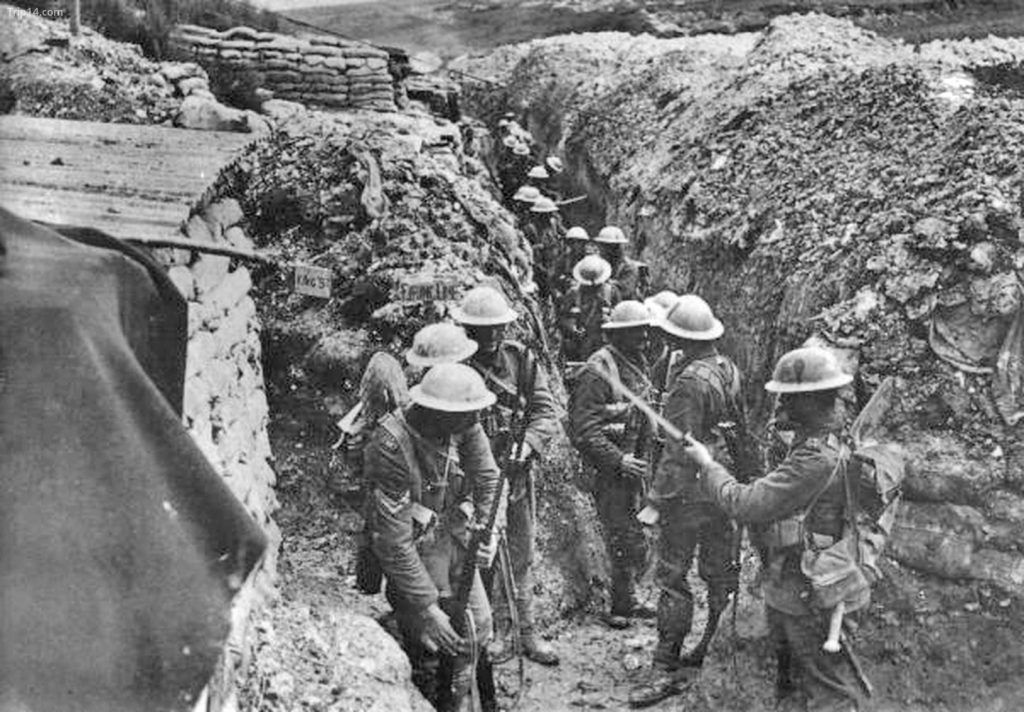In my last post, I described how Winnie the Pooh may be seen as Milne’s attempt to describe his PTSD to his son. However, the Battle of the Somme affected more than one famous author. J.R.R. Tolkien was also there, and his experience shaped his work, as another one of Eric Milzarski’s articles on We Are The Mighty explains.
In June 1916, the newly commissioned lieutenant kissed his newly married wife goodbye as he boarded the transport to Calais, France. Come July 1st, one of the bloodiest battles in human history took place near the Somme River. That day, his closest friend was killed and Tolkien forever changed.
Shouldering the burden of leadership and the ever-looming threat of death, by disease or the enemy, Tolkien carried on until Trench Fever sent him home ten days before the dust settled. Deemed no longer medically fit for service, Tolkien returned to his passion: writing.
WWI and Lord of the Rings
Tolkien hated direct comparisons of his works to real-world events. No real-world leader is Sauron. No real-world army are the orcs. And the One Ring is not a reference to the nuclear bomb.
In fact, when the second edition of The Lord of the Rings was released, the foreword clearly stated:
“The real war does not resemble the legendary war in its process or its conclusion. But I cordially dislike allegory in all its manifestations, and always have done so since I grew old and wary enough to detect its presence. I much prefer history, true or feigned, with its varied applicability to the thought and experience of readers.”
Even so, much of the psychology and emotions of his works did pull from his time on the battlefield. A notable example is the Dead Marshes. In the second volume (and film) The Two Towers, the ghoulish Gollum leads the protagonist, Frodo Baggins, through a swamp full of bloated bodies under the mud and water.
Tolkien’s biography, The Letters of J.R.R. Tolkien, explained that what Frodo experienced in the Marsh was specifically based on the Battle of the Somme where Tolkien saw countless bodies across the muddy battlefield.
Themes were also pulled from his leadership and the bravery of his men. Tolkien studied at Oxford and led men from mining, milling, and weaving towns of Lancashire. In his own words, Tolkien “felt an affinity for these working class men, but military protocol forbade him from developing friendships with ‘other ranks’.” This man-apart mentality can be also seen in many of the characters in his novels.
A Changing World
One of the largest changes from the novel to any film adaptation is the “Scouring of the Shire” and the mindset of Frodo after the war. In the final chapters of the last book, Saruman attacked the Shire and all of the townspeople had to defend their home.
Afterward, Frodo was left alone. He’d been stabbed, poisoned, and lost a finger. But the most important change was within. War had changed him. Frodo couldn’t just return to being a happy, singing Hobbit like everyone else after the war.
Neither could Tolkien. The forward of the 1991 release of The Lord of the Rings added another Tolkien quote:
“The country in which I lived in childhood was being shabbily destroyed before I was ten. Recently I saw in a paper a picture of the last decrepitude of the once thriving corn-mill beside its pool that long ago seemed to me so important.”
The enemy had been defeated. However, like Frodo, a shell-shocked Tolkien was now facing a world that was changing fast – and not necessarily for the better.






War is the cruelest thing that humans do. It inevitably leads to terrible, painful losses of life. It’s an experience that often changes people for the worse. Only the strong or those who find a means to express that suffering in a wholesome way can recover.
Couldn’t agree more. One of the things that bother me the most is the glorification of war and violence in much of modern media.
Fascinating, Nicholas. Tolkien may have insisted that he wasn’t making a political statement or writing about WWI. But war is war, and we can’t help but write what we know. Thanks for sharing.
That’s so true! Thank you, Diana 🙂
Can C.S. Lewis be far behind?
I have to research that!